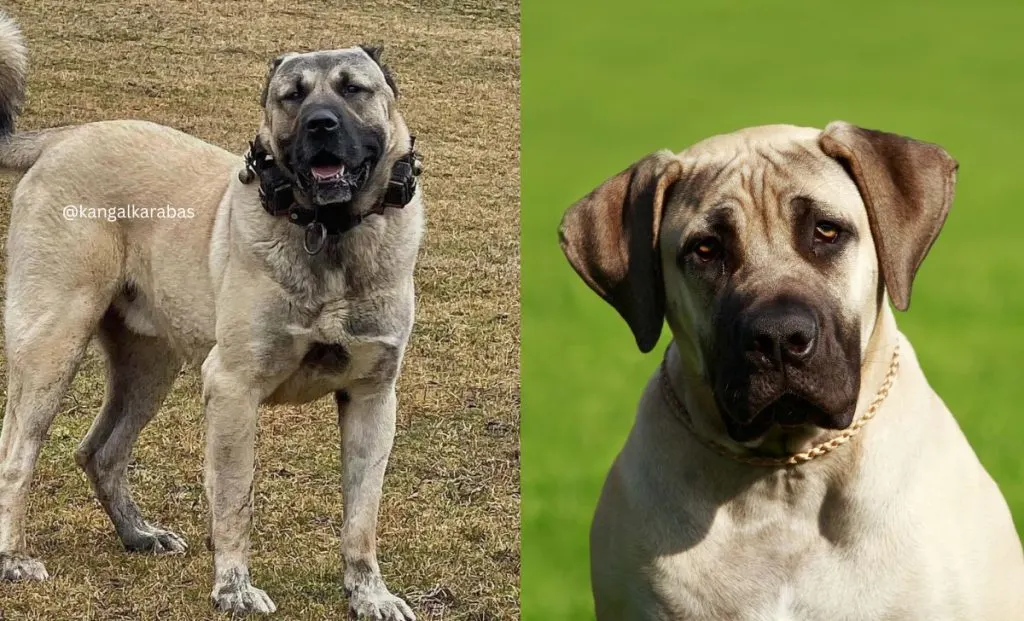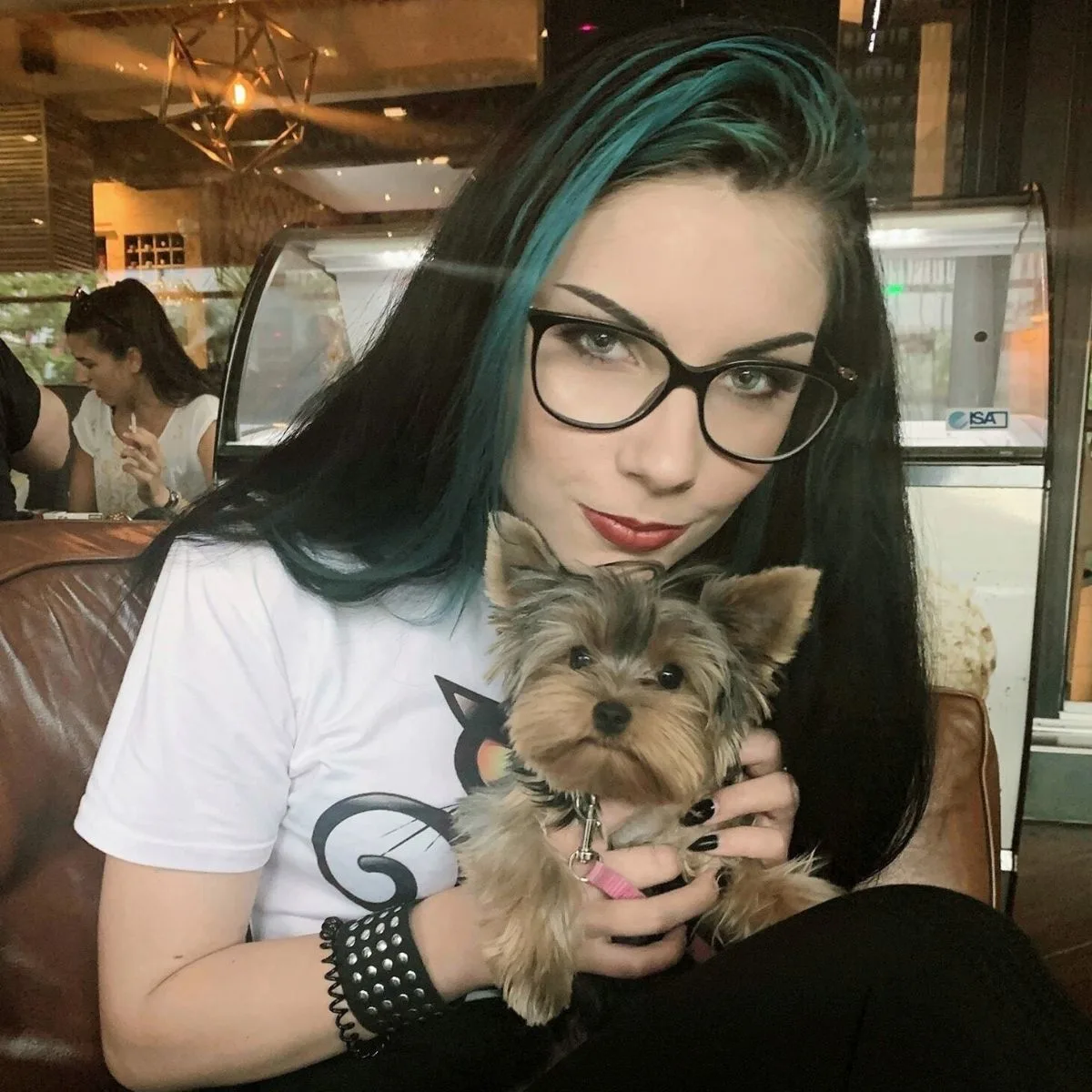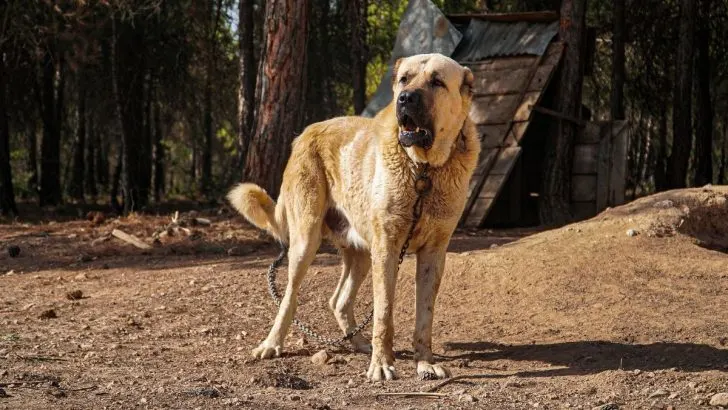Anatolian Shepherd vs. Kangal – if there ever was a clash of Titans, you’re looking at it now!
These two huge dogs have many common traits. Some people believe they are one and the same, others already have their favorite.
Either way, similarities are effortless to see. These two dogs look so alike, it’s easy to understand why it’s challenging to separate the two – if they even are different.
So, what’s the deal with the Anatolian Shepherd vs. Kangal competition? What are the differences between them, and which one is better? Let’s discover for ourselves!
Anatolian Shepherd Vs Kangal Overview
| Anatolian Shepherd | Kangal | |
| Height | 26 – 30 inches | 28 – 33 inches |
| Weight | 80 – 140 lbs | 90 – 145 lbs |
| Temperament | Independent, protective | Affectionate, loyal |
| Lifespan | 10 – 13 years | 12 – 15 years |
| Accepted by AKC | Yes | No |
| Accepted by FCI | Yes | No |
| Accepted by UKC | No | No |
Is Anatolian Shepherd The Same As Kangal?

Before we get deeper in the Anatolian Shepherd vs Kangal debate, it’s important to first see whether they are the same. This entirely depends on who you ask.
According to the American Kennel Club (AKC), the short answer is: Yes, the two are the same dog breeds called the Anatolian Shepherd.
Fédération Cynologique Internationale (FCI) seems to agree, except it considers both to be called the Kangal Shepherd.
However, the United Kennel Club (UKC) disagrees and considers both to be a different breed. The Turkish Kennel Club has the same stance, as it considers Kangal to be an official breed, but not Anatolian Shepherd.
I think this is quite important, as both dogs originate from Turkey.
Breed Histories
To understand the discrepancies in opinions, it’s important to understand the history of both breeds.
The Kangal is a Turkish dog that comes from the Sivas province of Turkey. It’s an ancient breed originating from the 11th century, if not even earlier.
It is believed to be distantly related to Caucasian Shepherd and Tibetan Mastiff but were bred to be smaller.
Kangal is a working dog that served as a livestock guardian and played a significant role in protecting flocks from large predators, such as wolves, jackals, and bears.
While Kangals did a good job of scaring predators away due to their intimidating bark and large stature, they had no problems participating in fights when necessary.
Due to this, the Turkish Kangal is considered a national treasure and is a highly beloved breed in its native land.
Anatolian Shepherd dog’s history, however, is a bit more tricky to track.
While some kennel clubs give it the same history as the Kangal, believing them to originate from the Anatolian region of Turkey, many experts agree on a somewhat different story.
The first Kangals were brought to the United States in 1985. Local breeders started breeding these dogs but with a few modifications.
These dogs were registered as Anatolian Shepherds with the AKC in the late 1990s, but the Turkish Kennel Club doesn’t agree with the changes made to the “true Kangal”.
As a result, the two are now considered a different breed in many parts of the world.
Appearance

Appearance-wise, the two dogs look almost the same. Even many experts would have an issue telling them apart!
They have a large frame, floppy ears, and a muscular body. However, there are some differences when it comes to coat color.
Both breeds typically come in tan or brown coats, with a black mask and black tail. However, while Kangals only come in this shade, Anatolian Shepherds can come in various colors, such as wolf sable, red, blue, and liver.
Anatolian Shepherds might have a somewhat stockier build, but don’t let this be a determining factor, as this largely depends on the dog’s eating habits, diet, and amount of exercise.
Also, while both dogs have short coats with a thick double coat, there are some minor differences in the coat type.
Kangals have shorter hair, with a coarse top coat and soft undercoat, while Anatolian Shepherds have just a bit longer fur, with a thick underlayer around their necks.
Size Difference
Another physical difference is in the dog’s size. While both dogs are rather huge, Kangals can grow to be larger.
If you look into their growth chart, you’ll see that Anatolian Shepherds usually grow up to 30 inches tall, which is still pretty large. However, Kangals typically reach a height of 33 inches!
The weight difference is not as significant. Anatolian Shepherds typically weigh between 80 and 140 lbs, while Kangals can reach up to 145 lbs. This is more than some humans!
As you can guess, their size adds to their striking look that will make everyone turn to look.
Temperament
There are many common misconceptions in popular culture about these large canines. People think they are bred mostly for dog fights, and that they are very aggressive, but this isn’t the case.
While it’s true that all dog breeds can be aggressive, this is typically due to the owner’s mistakes or abuse. Both Kangals and Anatolian Shepherds are no different. So, what is the true temperament of these two dogs?
These two dogs have strong protective instincts. They make amazing guard dogs, and this is why most people nowadays decide to own them. However, this is where most of their similarities end.
Kangals are known for their calm demeanor, which contrasts their territorial behavior. They form strong bonds with their human family.
On the other hand, Anatolian Shepherds have an independent nature and don’t have as close bonds with humans – other than with the “leader of the pack”. This doesn’t mean they are aggressive, they simply aren’t as affectionate as Kangals.
Which Is a Better Guard Dog?
It’s challenging to say which one is a better guard dog between the two. Both of these canines are excellent watchdogs, and you won’t make a mistake with either one of them.
Kangals are known for their fierce loyalty and bravery. No intruder will dare enter your home once they see this huge dog. In fact, they are probably better guard dogs than German Shepherds, which cannot be said for many breeds.
While intelligent, they are also stubborn, which might be a bit problematic when it comes to trainability. However, if you are persistent and use lots of positive reinforcement, you won’t have that many issues with dog training.
Anatolian Shepherds’ temperament is similar in the fact that they also have strong protective instincts, and they’ll gladly do anything they can to protect their owners. However, due to their independent nature, you might have some trouble training them.
Also, as Anatolians have a smaller size, they might not seem as fierce and intimidating as Kangals, although I doubt any burglar would notice the difference.
So, no matter which dog you decide upon, you can be certain they will complete this duty effortlessly.
Which Is The Better Family Dog?

If you’re choosing a pup for your whole family, especially if you have small children, this is where you need to think more.
In general, Kangals are a perfect blend of calm demeanor and protective instincts, making them excellent for keeping your children safe.
Of course, I wouldn’t allow Kangals or any other dogs near your little ones if you didn’t socialize them properly.
Early socialization is crucial with any dog that was bred for duties such as livestock guardian or war dog, as they might have a bit more of aggressive streaks than some other breeds.
Anatolian Shepherds, on the other hand, might be a bit more aloof and reserved, and they don’t have that much patience for little kids. While this doesn’t necessarily make them dangerous, they require more work if you plan on allowing children around them.
So, in this competition, my vote goes to the excellent companion and guard Kangal.
Still, if you want to be certain some negative traits these two dogs have are nullified, maybe you’d want to look into some Kangal or Anatolian Shepherd mixes instead.
Health
When it comes to health problems, I have some good news: Both dog breeds are very healthy, thanks to their working dog heritage.
Some health problems these dogs might be prone to include:
- Allergies
- Elbow and hip dysplasia
- Eye problems such as entropion
- Hypothyroidism
- Panosteitis
- Degenerative Myelopathy
- Osteochondrosis Dissecans (OCD)
- Bloat (Gastric Dilatation-Volvulus)
Many of these conditions can be prevented by proper diet and regular exercise. Of course, for your Anatolian Shepherd and Kangal’s safety, regular vet visits are a must.
This is the only way you can ensure your pooch is in good health.
Lifespan
Considering that both breeds struggle with similar health conditions, you are probably expecting them to have the same lifespan. However, this is where you can see some slight differences.
Kangals have an average lifespan of 12 to 15 years. This is extremely long for a large breed, considering how they often tend to live shorter than small dogs.
On the other hand, Anatolian Shepherds tend to live between 10 and 13 years.
This shouldn’t affect your opinion of the breeds, however. There are many factors that affect a dog’s lifespan, including genetics, care, and other external factors. What’s important is to strive to give your dog the best life possible, no matter how much time he has.
Which One Is Better For You?
So, now you have it: Anatolian Shepherd and Turkish Kangal can be considered one breed, or they can be considered separate ones. It all comes down to the matter of perception.
However, the main reason why someone would look for Anatolian Shepherd vs. Kangal differences probably is to determine which pooch is a better option for them.
Both dogs share their distinctive appearance, including tan and black coloring, a dense double coat, and a large stature.
However, their temperaments are quite different, and this might affect your final choice.
In general, Anatolian Shepherds might be a better choice for people who live alone or in small families and who would want an excellent guard dog that will protect them with their lives.
Kangals, on the other hand, are excellent protectors for large families and owners with small children, and they might be a bit easier to train.
Remember that neither of these two dogs is a good fit for inexperienced dog owners, so make sure you’ve got what it takes before taking them in!

Vanja’s passion for writing started at an early age, which is why she pursued Journalism as her college degree. She can research any topic and find all the information before you bat an eye, which is a great thing for her job but a terrible one for her husband.
Even as a young child, she fell in love with everything fluffy – but dogs have a special place in her heart due to her childhood companion, a Corgie named Archie.
Motivated by her experiences and driven by a desire to give back to her four-legged companions, she spends her free time volunteering at a local dog shelter.
